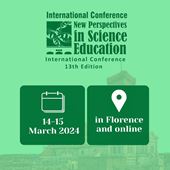Science Education and Social Networks
Carola Ciccarese, Istituto Zooprofilattico Sperimentale dell’Abruzzo e del Molise (IZSAM) (Italy)
Ombretta Pediconi, Istituto Zooprofilattico Sperimentale dell’Abruzzo e del Molise (IZSAM) (Italy)
Giorgia Canulli, Istituto Zooprofilattico Sperimentale dell’Abruzzo e del Molise (IZSAM) (Italy)
Barbara Alessandrini, Istituto Zooprofilattico Sperimentale dell’Abruzzo e del Molise (IZSAM) (Italy)
Abstract
Vocational education is one of the key aspects of the National school reform entered into force in 2015 in Italy. Traineeships became compulsory for students in the last three years of the upper secondary schools. The reform was inspired by the European policies on lifelong learning of the last decade, mainly addressed to satisfy needs arising from various actors: educators, students, stakeholders.
IZSAM is a public health body belonging to the Italian National Health System. The Institute provides scientific and technical support to the National and Regional Governments in veterinary public health. Since the early nineties, IZSAM delivered health education programs to students of primary and secondary schools. In response to the reform requirements, IZSAM developed a work-based education project titled “Digital Natives at work” devoted to 72 students aged 15 to 17 and belonging to 4 secondary schools.
Social media were used as tools to disseminate science in a rapid, exact, visible and smart way. 95% of high schools students, in fact, are users of at least one social network, 20,5% use social media more than 3 hours per day: these and other statistics represented the social and cultural background and the premise of the project planning.
The work-based learning focused to promote knowledge, skills and correct behaviours on food safety, animal health and veterinary public health. Students used some of widespread digital communication tools (blog, Facebook and Whatsapp) to disseminate adequate healthy approaches among the group of peers.
The implementation of a public Facebook profile and two blogs, using specific narrative and communication techniques, were the main project outputs.
The monitoring system focused on the evaluation of students’ involvement in the project, the number of followers of the Facebook profile, the competences acquired (scientific knowledge, technological skills and transversal abilities).
The initiative will last three years: the next phases will support the achievement of students’ independence in developing digital communication plans to address scientific messages. The encouraging results achieved show that science based communication plans can increase their success choosing language and means suited to the target needs. Further studies are necessary to measure impact and target response.
References:
 New Perspectives in Science Education
New Perspectives in Science Education


























